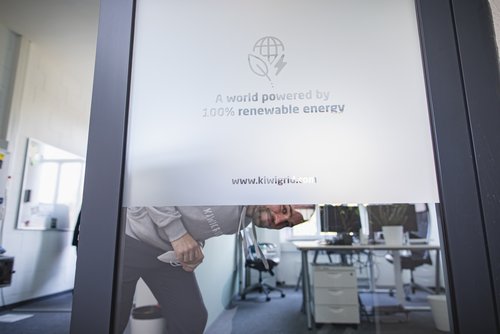The basis for real climate action is the calculation and analysis of emissions - because only by being aware of our carbon footprint do we know where our CO2 emissions come from, and understand how we can avoid and reduce them. Since 2019, we at Kiwigrid have therefore been measuring our corporate carbon footprint – the sum of all CO2 emissions that we cause within a year as a company - in cooperation with ClimatePartner.
All emissions caused by our employees during working hours are included in the calculation. Emissions that can be saved by our products are recorded separately and are not included in this calculation. Our carbon footprint is calculated on the basis of utility bills, which are not published until the following year. For this reason, our report looks back two years, i.e. to 2021.
How we measure CO2 emissions
To determine our carbon footprint, we record all data that contributes to it. A distinction is made between Scope 1, 2 and 3:
- Scope 1 includes all directly generated emissions, for example from company-owned facilities or our vehicle fleet.
- Scope 2 lists emissions caused by purchased energy, for example electricity and district heating.
- Scope 3 includes all other emissions that are not under the direct control of the company, for example our employees’ travel.
We record all these emissions in charts. ClimatePartner provides helpful tools for this purpose. The process is led by our Product Marketing Manager Martin Himstedt, who is actively supported by our team assistant Katja Bramborg. Once all the data has been compiled, our carbon footprint is calculated.
Our carbon footprint in 2021
Our CO2 footprint in 2021 was 222.45 t CO2, which is equivalent to the average CO2 footprint of 26 Europeans. We will compensate for the CO2 emissions by donating a total of 5,255 € to climate protection projects through our partner ClimatePartner.
Most of the emissions were generated in the area of mobility. Due to Germany’s COVID-19 regulations, this was significantly lower in 2020, which also explains the increase in emissions compared to the previous year (2020: 173 t CO2). Furthermore, we had to turn up the heat in our office because more colleagues were working at the Kiwigrid site again.
What we want to do now
After analyzing our carbon footprint, we look at how we can best reduce it sustainably. For example, we are currently examining which data centers are particularly low in emissions. Such ideas are then taken directly to management.
We record all these emissions in charts. ClimatePartner provides helpful tools for this purpose. The process is led by our Product Marketing Manager Martin Himstedt, who is actively supported by our team assistant Katja Bramborg. Once all the data has been compiled, our carbon footprint is calculated.

With our emissions stemming once again from mobility in particular, we have been looking for practical ways to make savings in this area. To make traveling by bicycle even more attractive, we provide business bikes. This means that employees can purchase company bikes via Kiwigrid, which can be charged to their salary just like a leased car.
We want to motivate employees for whom cycling is not an option to use public transport instead of their own cars. For this purpose, Kiwigrid also offers the Deutschland-Ticket (also known as the 49-Euro-Ticket) with a subsidy of 30%, in addition to a Jobticket.
As a company, we have also switched from a Caddy lease to the climate-neutral car-sharing provider Teilauto. In addition to lower emissions, car sharing also offers the advantage of always having a suitable car available at the right location for all employees.
A recent survey of employees showed that around 50% of them already cycle or walk to work, and many others use public transport. Only journeys from the countryside are often only possible by car.
How we offset our emissions
We offset the resulting CO2 emissions every year with certified climate protection projects. Sustainable development in Africa is especially important to us. The African continent faces many social, economic, health and environmental challenges. The transition to an energy system based on renewable sources such as wind, solar or hydropower is key to sustainable development to address these challenges, in particular to mitigate the effects of climate change and provide access to clean and affordable energy for all. Here, we are specifically participating in a portfolio of different projects enabling solar and wind energy in Madagascar, Namibia, Egypt and South Africa.
In addition, we support the training of local stakeholders in sustainable forest management in Brazil. The 72,843-hectare area of the forest conservation project in the Brazilian state of Rondônia serves as a protector of the region's rich biodiversity. The goal is to improve the quality of life for local people by training farmers in sustainable agriculture and forestry, thereby strengthening social responsibility. Other objectives include the conservation of biodiversity, including the protection of various wildlife species. The project has been recognized by the UN Food and Agriculture Organization (FAO) as exemplary for sustainable forest management in Latin America and the Caribbean (2010) and is certified by the Forest Stewardship Council (FSC) as a global reference for sustainable timber production.
Our sustainable commitment goes beyond CO2 compensation
At Kiwigrid, we are also committed to sustainability in many areas beyond CO2 capture and offsetting:
- Last Christmas, we decided to use the money we usually spend on gifts and greeting cards in a sustainable way and in the spirit of a fast energy transition. So we donated 3.000 € to the Cucomo organization to support the Banhine Solar project instead. The money was used to build a solar plant in Banhine (Mozambique), which now supplies a local village school with light, electricity and internet.
- At the beginning of April, in honor of the "International Day of Zero Waste," we met for a garbage collection campaign on the Elbe River.
Is sustainability also an important subject to you? Join our team!
